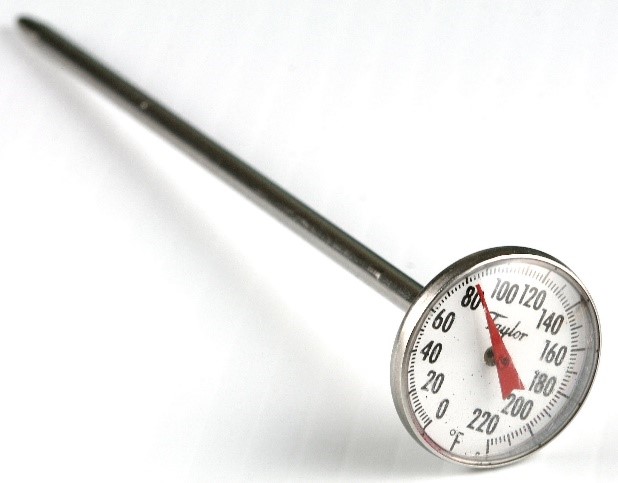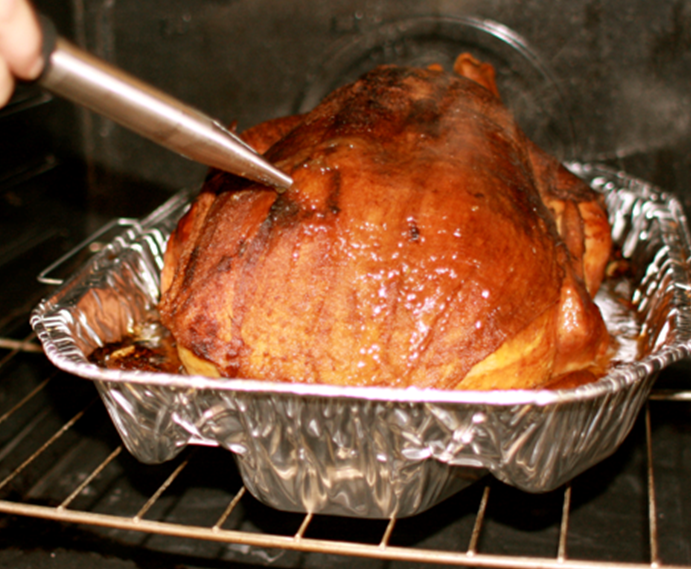BY: NORA IDRINA
Thanksgiving Turkey Science: The Sequel
For the last article, I did a bit of research to find out why Thanksgiving turkey is so hard to get right. Ultimately it boiled down to having to balance cooking time and temperature to minimize moisture loss and muscle fiber denaturation while maximizing the conversion of collagen to gelatin; issues further complicated by the different types of meat indifferent parts of the bird, as well as the overall shape and size of the turkey.
I discovered that brining, basting, flipping, and tenting were methods typically employed during roasting to help impart flavor, reduce moisture loss, and even out cooking throughout the bird. In this article, I’d like to explore those steps and break them down further, take a quick look into turkey stuffing, and hopefully aide in our ability to cook a perfect turkey (: So without further ado, let’s jump right in!
Brining
Brining is basically soaking the turkey in a saltwater solution (usually 3-6% salt by weight) to seal in moisture and improve texture (1). It’s a useful method, particularly for the white meat in the breast that’s prone to drying out during roasting. However, it also takes up a lot of time, a lot of fridge-space, and it can make the turkey and its drippings a little too salty so it’s a step that folks sometimes prefer to forgo.
The argument for brining is that it helps to keep the turkey meat from losing too much moisture as it cooks. When brining, the idea is that you want water to travel into the meat and to stay there. Technically, you could just soak the turkey in plain water and let osmosis do its job as the water travels from a region of low solute concentration into the turkey, a region of high solute concentration. Unfortunately, doing so wouldn’t change anything once the bird is cooked. The water leaves all the same.
This is where the salt in a brine comes in handy: it travels along with water into the bird where it interacts with and disrupts the protein filaments of muscle fibers. During cooking, the muscle fibers would typically contract and clump together in aggregates. Once disrupted by salt, though, the fibers are not so capable of tangling together upon denaturation, so you end up with looser aggregates of fibers and consequently, more tender meat. These loosened-up fibers are also now capable of holding more water in them so they suck-up water from the brine and keep it there as the bird cooks (2).

Turkey brining (By Lindsey on Flickr)
Moisture loss during cooking is inevitable, but by equipping the bird with a healthy dose of salt, the moisture loss is mitigated. The problem with using a brine of salt and water, however, is that the turkey ends up tasting too salty or watered down. Some sources recommend using flavorful liquids like stock or buttermilk but there’s often not much guarantee that the flavor makes its way into the bird because the size of the flavor compounds may be too large to enter the muscle fibers. So, to enhance flavor, an alternative method growing in popularity is to thoroughly salt the surface of the bird via a procedure known as dry-brining or salting.
Turkeys are 60% water (3). Salting the bird takes advantage of these natural juices as the salt on the surface of the bird draws out the turkey juice via osmosis. The salt then dissolves in the juices and forms a brine which then travels back into the bird, breaks down muscle fibers and reabsorbs the meat juices (4). If you add some baking soda to the salt too, it helps to break down the proteins on turkey skin, releasing more amino acids that can be very useful in the inevitable Maillard reaction occurring in the hot oven (4).
Cooking time and temperature
When cooking a whole turkey, regardless of the size of the bird, the USDA recommends setting the oven to at least 325⁰ F/163⁰ C (5). Cooking time is a little harder to determine. Generally, the cooking time depends on the thickness of the entire bird. Solving thermal diffusion equations suggest that the best cooking time for the bird is based on two factors: the temperature difference between oven and turkey and the square radius of the bird (3).
Realistically speaking though, no one wants to actually measure the turkey and do the math to determine this so your best bet is to use a food thermometer to check that the turkey center has reached 165⁰ F/73⁰ C (5). If you’d like to be more certain, FSIS (Food Safety and Inspection Services) also has a handy guide for cooking times based on the weight of the turkey (5).

Meat thermometer (By: Steven Jackson on Flickr)
The battle for the perfect bird truly begins once it starts roasting because this is when it must be carefully monitored to prevent under or overcooking. It’s at this point that the competing demands of the muscle fibers, collagen, moisture, dark and white meat need to be dealt with. Different sources recommend different methods to handle these concurrent issues.
Basting, flipping, and tenting
Since the turkey is being cooked at a pretty high temperature, some sources recommend basting to help keep the breast meat of the turkey from drying out. The pan that the turkey sits in as it roasts acts as a barrier to the heat from the oven so the parts that need the heat the most (legs and thighs) end up getting heated the least. One way to compensate for this is to baste the more exposed breast of the bird while giving the more shielded parts more time to cook (2).
Basting makes use of flavorful liquids like melted butter, broth or even the turkey’s own pan drippings as it cooks to impart flavor and to keep the meat from drying out from the high oven heat. These liquids are spooned or poured over the top of the turkey breast and then allowed to drip down over the sides of the bird. The idea is that the liquid that is poured onto the turkey surface evaporates in the high oven heat and subsequently cools the breast meat of the bird down, helping to slow down cooking and reduce moisture loss while imparting flavor into the bird (5).

Turkey basting (By Katie Inglis on Flickr)
Unfortunately, because you need to baste the turkey frequently (every 30-45 minutes), you would need to open the oven door several times, which in turn, lowers the temperature within the oven and prolongs cooking time even more. Overall, unless you’re careful, you still have a pretty high risk of under or overcooking the bird. Another way to ensure more even heating throughout the turkey is to expose its lower-half and shield its upper-half by flipping the bird. However, unless you’re cooking a relatively small turkey, this may not be the best idea because it involves manually turning over a huge, hot, greasy bird. Needless to say, this is not an easily accomplished task.
Instead of basting or turkey-flipping, another method is “tenting” or covering the more heat-sensitive turkey breast with foil. This helps to deflect heat from the turkey breast and slow its cooking while the lower half plays catch-up and cooks to completion (2). Since this process involves neither opening the oven door several times nor wrestling with giant, scorching poultry, this might be the safest and most fool-proof option.
Stuffing
Another important consideration when cooking a whole turkey is stuffing. While traditionally turkeys are stuffed and then roasted, due to food safety concerns, it’s no longer advisable to do so. It takes a while for heat to get from the outside of the turkey to its center. The turkey is only safe to eat once its center has reached a safe temperature.
If a turkey is stuffed, the juices from the meat leak into the stuffing, which can be a good thing flavor-wise but not such a good-thing safety-wise. Turkey has to be cooked to 165⁰ F/73⁰ C all the way through to kill off any existing bacteria that may cause illness. The turkey juices that leak into the stuffing may also contain some harmful microbes, so it is important to ensure that the stuffing within the turkey is cooked all the way to 165⁰ F/73⁰ C as well (7).
To cook the stuffing to the desired temperature means that the turkey must stay in the oven a little longer, potentially compromising the quality of the bird. A much safer method would be to cook the stuffing in a casserole dish separately but to do so means losing out on the flavor imparted by turkey juices that stuffing is meant to absorb. One way to overcome this issue is to use turkey stock in the preparation of your stuffing (8) or you could collect some drippings and juices from the roasting turkey, mix them with the stuffing and then cook the stuffing separately in a casserole dish to completion (9).

Cook turkey stuffing separately for safety! (By Betty Crocker Recipes on Flickr)
Conclusion:
The practice of roasting turkeys for Thanksgiving has been around for a long time. As such, there are many methods of turkey preparation and cooking out there to choose from. Overall, some methods, especially those designed for safety, need to stay the same. For instance, it’s okay to use a rough guideline for determining the cooking time for the bird as long as it is only taken out of the oven once its center has reached 165⁰ F/73⁰ C. Also, after taking the bird out of the oven, it must be left to rest for 20 minutes before carving or you risk losing the moisture you’ve worked so hard to retain within the turkey.
On the other hand, for some methods, certain processes work better than others. From what I’ve learnt about the science behind brining, dry brining is more efficient than wet brining for retaining moisture and turkey flavor. During roasting, tenting is the safest and most efficient method to allow even heat transfer. Stuffing should not go into the bird unless you’re willing to increase the cooking time to allow it to reach a safe temperature, so its probably better not to stuff the bird at all. Instead use other means of imparting turkey flavor into the stuffing as it cooks separately from the bird.
All in all, understanding the make-up of a turkey clarifies the necessity of certain steps over others. At the end of the day, if you’re comfortable with a specific method and it’s proven to work well for you, there’s no harm in sticking to it (provided its safe) but it helps to know that there are other ways that work just as well if not better according to .
References:
- http://www.washingtonpost.com/wp-dyn/content/article/2007/11/13/AR2007111300406.html
- http://wtf.tw/ref/mcgee.pdf
- https://phys.org/news/2005-12-cook-turkey-scientific.html
- https://www.seriouseats.com/2014/11/quick-and-dirty-guide-to-brining-turkey-chicken-thanksgiving.html
- https://www.fsis.usda.gov/wps/portal/fsis/topics/food-safety-education/get-answers/food-safety-fact-sheets/poultry-preparation/lets-talk-turkey/CT_Index
- https://www.thekitchn.com/is-it-necessary-to-baste-the-thanksgiving-turkey-102290
- https://www.cdc.gov/features/turkeytime/index.html
- https://www.tasteofhome.com/article/cooking-stuffing-in-a-turkey-can-be-dangerous-heres-why/
- https://www.seriouseats.com/2014/11/buying-prepping-cooking-carving-thanksgiving-turkey-complete-guide-food-lab.html#stuffbutterfly






Leave a Reply